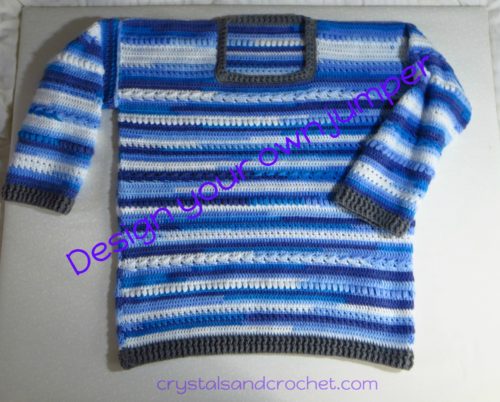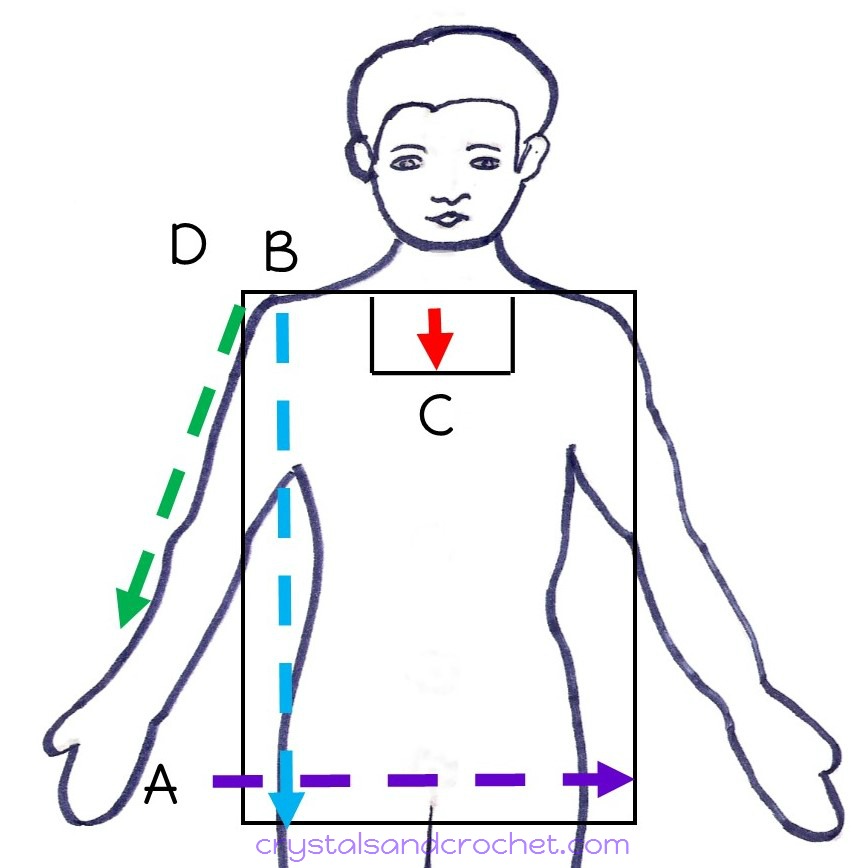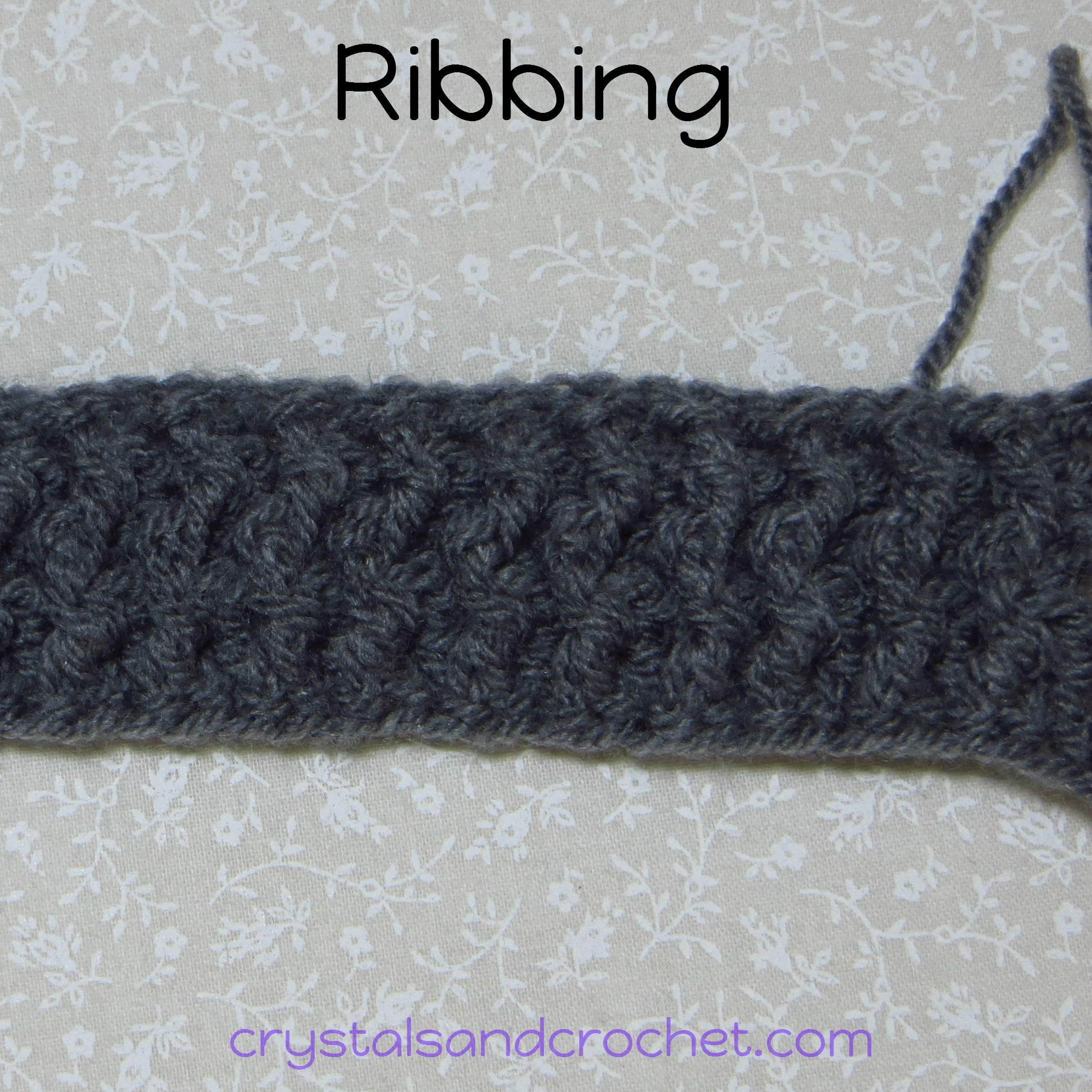Sign Up
Already have an account? Sign in here
Sign In
Dont have an account? Sign up here
Design your Own Jumper

How to Design your own Jumper
Making a simple jumper or pullover is far easier than you may think.
I am a great fan of jumpers. I love to feel cozy, either slopping about at home or with jeans and a pair of boots, dress them up or throw a gorgeous scarf or shawl around your neck and you are set for any weather.
The key things to get right are; your measurements and your pattern repeat (if you are going to use a pattern).
The wonderful thing here, is that you can make this any size and any stitch pattern you like. So this is instructions how to, rather than a pattern to follow.
So, first let’s look at the measurements you will need.
♥ A. Measure around the widest part of your torso, and add 8 inches/20cm.
Divide by 2 to get the width of front and back pieces.
♥ B. Measure from shoulders down to where you want the bottom of your jumper to be.
This is the length you will work for front and back pieces.
♥ C. Measure from top of shoulders to bottom of desired neckline.
You can make the neckline any shape you want, square is very easy, as all you need to do is divide your front width by 3, one 1/3 will be the neck spaces and one 1/3 either side.
♥ D. Measure your sleeve length from shoulder to wrist (or whatever length you require).
♥ E. Measure around the top of your arm, and around your wrist. Add 2 to 4 inches / 5 to 10 cm to both measurements, depending on how tight or loose you want the fit to be.
You may use any yarn and hook you like to work with.
♥ You can use any pattern you like, or make up your own as I did.
Or you may want to just use simple, basic stitches.
If you do make a patterned stitch, then make sure you have the correct number of stitches for the repeat of your pattern, and, normally you will also need 1 extra stitch for each end.
Mine uses stitches that are worked over 2 stitches, crossed dc and puff st, and over 4 stitches. cable st, so my repeat needed to be multiples of 4 plus 2.
Hint: place a locking stitch marker in 1st stitch of each row, moving it up each time you turn and start a new row. This will keep your sides straight and stitch count even.
Ribbing.
US terms dc/ UK terms tr
Hint: as you work the ribbing ensure as you turn and work across each row you are working fpdc around bpdc, and bpdc around fpdc, so that your work is the same on both sides.
1. Work foundation dc, (or chain and work in back bumps), to required width for back piece.
2. Turn. Ch 1, fpdc around 1st st, (bpdc around next st, fpdc around next st) repeat to end, bpdc around last st.
3,4 repeat row 2
Again, you may work as many rows as you like for your ribbing, or none at all.
Continue to work your back piece to the desired length.
For the front, work exactly as the back until you reach the length to the bottom of the neck.
Work one side and then the other finishing with the same length as the back.
With a spare piece of yarn, work slightly loose slip stitches up the sides of the neck line on each side. Remember to make 1 sl-st in each sc, 2 in each dc, and 3 in each tr.
Esther from itsallinanutshell.com has a great video tutorial for this. It will give you a very neat and tidy edge when you make the extra stitches around the neckline.
Join front and back at shoulders only.
This is to double check your sleeve length, pop it over your head and measure the sleeve length again from shoulder to wrist.
To make your sleeves.
Using either back or front, work out how many stitches per inch/cm you have, this will vary, depending on the yarn and hook size you have used.
You then need to work out the increase in size from wrist measurement to upper arm measurement.
I wanted 12 inches/30.5cm at the wrist, and 16 inches/40.5cm at the top, so I have an increase of 4 inches/10cm.
I have 5 sts per inch/2.5cm.
Wrist starts with 60 sts and I need to increase to 80 sts, an increase of 20 sts.
To make an increase make 2 sts in the 1st and last stitch of a row, and space the increases out evenly as you work the sleeves.
To work out how many rows you will have in your sleeves, simply lay a tape measure on the front or back piece and count the number of rows including the ribbing to make up your sleeve length. Divide the number of rows by ½ the number of increases you need to make, and this will give you the frequency that you need to make an increase.
I have 53 rows for my sleeve, so I made an increase on every 5th row after the ribbing.
Once your sleeves are made, find the centre stitch at the top, using a locking stitch marker join to shoulder seam.
Join sleeves to main body, and then join front and back, from bottom of body all the way to wrist ribbing.
Neckline.
If you are making a square neckline as I did, then in the corners you will need to work 3 stitches together, to make the neckline lay flat.
I made 1 round of sc in each stitch, with sc3tog in each corner, then I worked 2 rounds of ribbing with fpdc3tog in each corner.
Work away all your ends and you now have a lovely, unique jumper, that you designed yourself.
♥ If you need help and advice, the quickest way to find support is to join Helen’s Hookaholics Facebook group. There you will find a very supportive group of likeminded people. It’s also a great place to share your crystalsandcrochet makes, and see what others are making, and see what I am up to.
♥ If you are not a fan of Facebook you can always email me with any questions you may have by using the contact form here.











